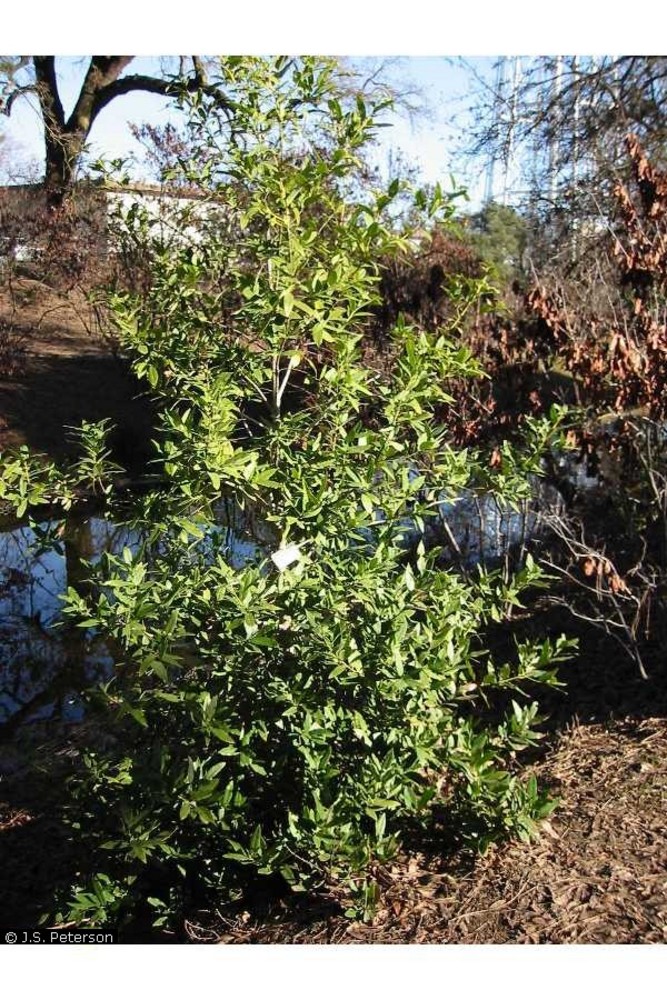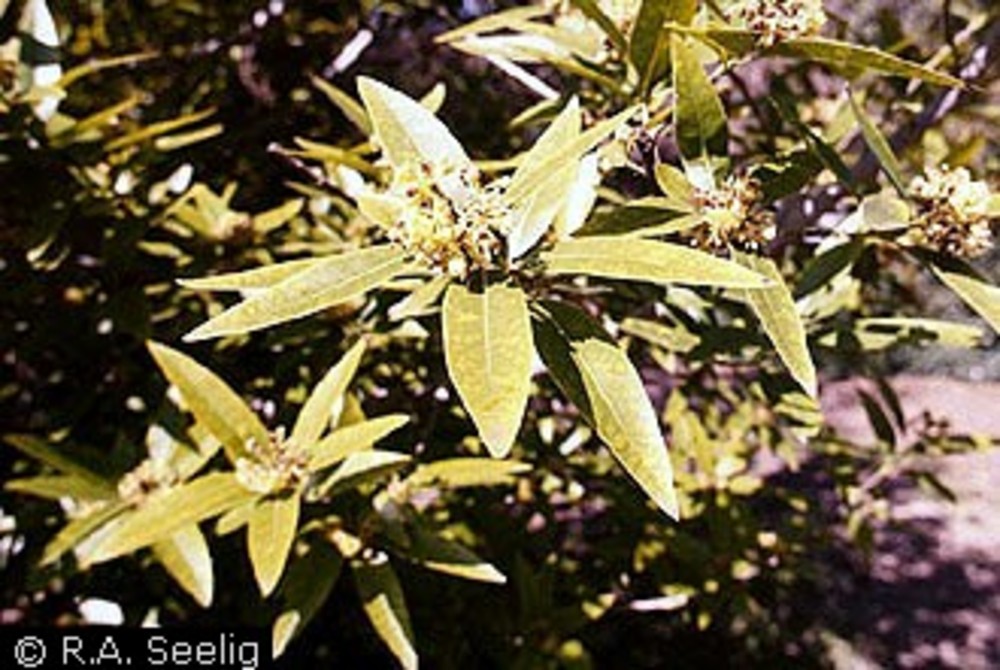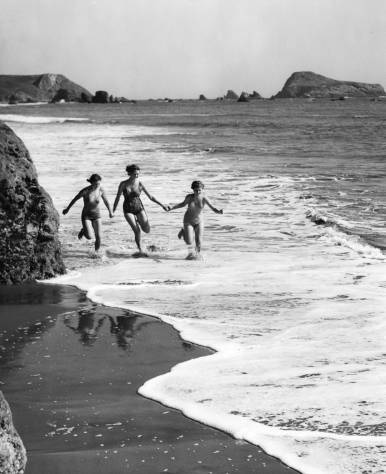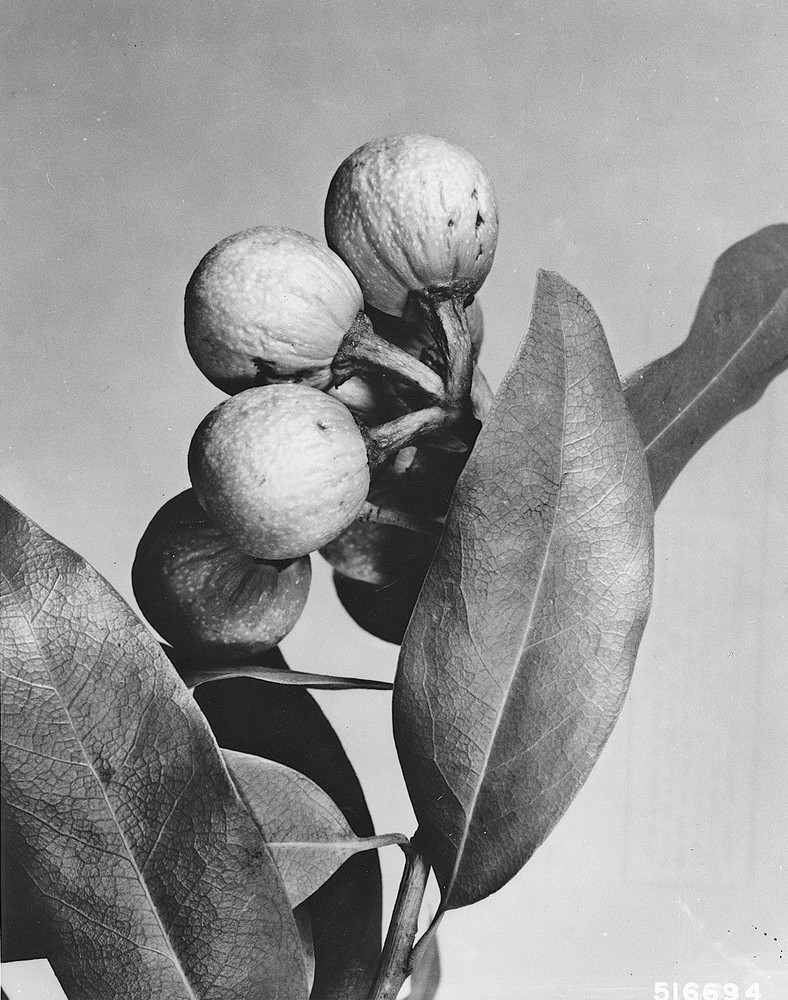The Oregon myrtle (Umbellularia californica) grows in a ninety-square-mile area of southern Oregon and in much of California, where it is known as the California laurel. A slow-growing bay laurel, related to camphor and cinnamon, its leaves are used in perfumes, candles, incense, and (when dried) seasoning. The West Coast myrtle is distinct from the myrtle of the Middle East and Mediterranean, which is Myrtus communis L. or common myrtle.
The wood of the Oregon myrtle is especially prized. Harder than oak, it has a wide color spectrum and variety of grains popular with consumers and woodworkers. Between 19,950 and 22,800 cubic meters are used annually for furniture, musical instruments, bowls and cutting boards, artwork, and other items.
In 1869, the Golden Spike was driven into a Laurelwood railroad tie to signify the completion of the transcontinental railroad. By the late 1800s, woodcarvers on the south coast of Oregon were using Oregon myrtle in their work, and in 1907 author Jack London commissioned J.H. Oerding to make furniture out of myrtle for his California ranch. In 1911, the earliest manufacturing operation was established, Duncan's Myrtlewood Crofters, which today is the Real Oregon Gift Factory in North Bend.
With U.S. 101 providing a stream of travelers, the Myrtlewood industry now encompasses both large manufacturer-distributors as well as many cottage artisans, most between Florence and Brookings. Today, competition and conservation are issues. Myrtlewood gifts compete for tourist dollars with mass-produced Oregon souvenirs, and carvers worry about the supply of wood, since the trees require many decades to mature.
For a while, at least, money did grow on trees. During the Great Depression, North Bend issued myrtlewood scrip after the town bank closed. The scrip is still redeemable today.
-
![Oregon myrtle (Umbellularia californica (Hook. & Arn.) Nutt.).]()
Myrtle, detail of.
Oregon myrtle (Umbellularia californica (Hook. & Arn.) Nutt.). Photo by Mark W. Skinner, USDA-NRCS PLANTS Database
-
![Oregon myrtle (Umbellularia californica (Hook. & Arn.) Nutt.).]()
Myrtle, bush.
Oregon myrtle (Umbellularia californica (Hook. & Arn.) Nutt.). Photo by J. S. Peterson, USDA-NRCS PLANTS Database
-
![Oregon myrtle (Umbellularia californica (Hook. & Arn.) Nutt.).]()
Myrtle, leaves of.
Oregon myrtle (Umbellularia californica (Hook. & Arn.) Nutt.). Photo by R. A. Seelig, courtesy of Smithsonian Institution
-
![Oregon myrtle (Umbellularia californica (Hook. & Arn.) Nutt.).]()
Myrtle, seeds of, detail.
Oregon myrtle (Umbellularia californica (Hook. & Arn.) Nutt.). Courtesy USDA-NRCS PLANTS Database
Related Entries
-
![Brookings]()
Brookings
Brookings is located at the mouth of the Chetco River, on the southern-…
-
![Myrtlewood]()
Myrtlewood
Oregon-myrtle (Umbellularia californica) grows along the Pacific Coast …
-
![US 101 (Oregon Coast Highway)]()
US 101 (Oregon Coast Highway)
Many places on the Oregon coast were virtually inaccessible in the earl…
Related Historical Records
Map This on the Oregon History WayFinder
The Oregon History Wayfinder is an interactive map that identifies significant places, people, and events in Oregon history.
Further Reading
"Myrtlewood Transforming Blocks into Works of Art." Bandon Western World, May 25, 2004.
Chatfield-Taylor, Joan. "Shopper's World: Silky Myrtlewood of Oregon's Coast." New York Times, March 15, 1987.
Gerkman, Laurel. "See it Made: Between Florence and Gold Beach, Nine Myrtlewood Factories Create their Own Products." Oregon Coast, July/August 2007.







